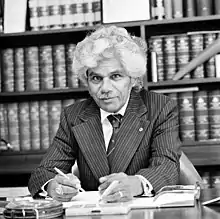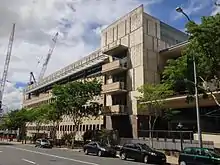Neville Bonner | |
|---|---|
 Bonner in 1979 | |
| Senator for Queensland | |
| In office 20 August 1971 – 4 February 1983 | |
| Preceded by | Dame Annabelle Rankin |
| Succeeded by | Ron Boswell |
| Personal details | |
| Born | Neville Thomas Bonner 28 March 1922 Ukerebagh Island, New South Wales, Australia |
| Died | 5 February 1999 (aged 76) Ipswich, Queensland, Australia |
| Political party | Independent (1983–1999) |
| Other political affiliations | Liberal (1967–1983) |
| Spouses | |
| Children | 5 boys |
| Occupation | Federal Senator |
Neville Thomas Bonner AO (28 March 1922 – 5 February 1999) was an Australian politician, and the first Aboriginal Australian to become a member of the Parliament of Australia. He was appointed by the Queensland Parliament to fill a casual vacancy in the representation of Queensland in the Senate, and later became the first Indigenous Australian to be elected to the parliament by popular vote. Neville Bonner was an elder of the Jagera people.
Early life
Bonner was born on 28 March 1922 on Ukerebagh Island, a small island in the Tweed River of New South Wales close to the border with Queensland. He was the son of Julia Bell, an Indigenous Australian, and Henry Kenneth Bonner, an English immigrant. His maternal grandmother Ida Sandy was a member of the Ugarapul people of the Logan and Albert Rivers, while his maternal grandfather Roger Bell (or Jung Jung) was a fully initiated member of the Yagara people of the Brisbane River. According to Bonner, his grandfather was "sort of captured [...] out of the tribe" as a young boy and given an English name.[1]
Bonner's parents met and married in Murwillumbah, New South Wales. His father abandoned his mother when she was pregnant with him, leaving her destitute. She subsequently moved to the Aboriginal reserve on Ukerebagh Island, where she had another son. After about five years, the family moved near Lismore, New South Wales, to be closer to Bonner's grandparents, living on the banks of the Richmond River under a lantana bush. His mother subsequently had three children with Frank Randell, an Aboriginal man who was employed by the local police. One of his half-brothers died as a child and he "witnessed frequent acts of violence by Randell against his mother".[1]
Bonner's mother died in July 1932, when he was ten years old, and his grandmother subsequently became his main caregiver. She moved the family to Beaudesert, Queensland, where in 1935 he completed his only year of formal education at Beaudesert State Rural School. His grandmother died in June 1935 and he moved back to New South Wales after finishing the school year.[1] Bonner worked as a ring barker, cane cutter and stockman before settling on Palm Island, near Townsville, Queensland in 1946, where he rose to the position of Assistant Settlement Overseer.[2]
Contribution to Parliament
In 1960 he lived in Ipswich, where he joined the board of directors of the One People of Australia League (OPAL),[3] a moderate Indigenous rights organisation. He became its Queensland president in 1970. He joined the Liberal Party in 1967 and held local office in the party. Following the resignation of Senator Annabelle Rankin in 1971, Bonner was chosen to fill the casual vacancy and he became the first Indigenous Australian to sit in the Australian Parliament. He was elected in his own right in 1972, 1974, 1975, and 1980.
While in the Senate he served on a number of committees but was never a serious candidate for promotion to the ministry. He rebelled against the Liberal Party line on some issues. Partly as a result of this, and partly due to pressure from younger candidates, he was dropped from the Liberal Senate ticket at the 1983 election. He stood as an independent and was nearly successful. The Hawke government then appointed him to the board of directors of the Australian Broadcasting Corporation.
In 1981 Bonner was the only government voice opposing a bill put forth that would allow drilling in the Great Barrier Reef. He regularly "crossed the floor" on bills, a characteristic that has endeared him to politicians today but is often considered the reason for his political career coming to an end.[4]
In 1979 Bonner was jointly named Australian of the Year[5] along with naturalist Harry Butler. In 1984 Bonner was appointed an Officer of the Order of Australia.[6] From 1992 to 1996 he was member of the Griffith University Council. The university awarded him an honorary doctorate in 1993. In 1998 he was elected to the Constitutional Convention as a candidate of Australians for Constitutional Monarchy.
Bonner died at Ipswich in 1999, aged 76.
Bonner's grand niece Joanna Lindgren was the first female Aboriginal senator for Queensland when she represented the Liberal National Party from May 2015 to July 2016.
Legacy


The head office of the Queensland Department of Communities, Child Safety and Disability services in Brisbane, built in 1999, was named the Neville Bonner Building.[7] Despite having won two architectural awards (the RAIA Beatrice Hutton Award for Commercial Building 1999, a national award,[8] and the RAIA (Queensland) F.D.G Stanley Award & Regional Commendation 1999), it was demolished in 2017 to make way for the Queen's Wharf development.[9][10] The Neville Bonner Bridge, a footbridge built in 2023, due and to open in 2024, is part of the new development.[11]
The Neville Bonner Memorial Scholarship was established by the federal government in 2000, a scholarship for Indigenous Australians to study Honours in political science or related subjects at any recognised Australian university.[12]
In 2002, the Neville Bonner Award for Indigenous Education was introduced as part of the Australian Awards for University Teaching (AAUT), which were established by the federal government in 1997.[13][14] The inaugural award was won jointly by Marcia Langton and Larissa Behrendt.[15]
A multipurpose 47-bed hostel, managed by Aboriginal Hostels Limited, located in the Rockhampton suburb of Berserker, was redeveloped and reopened in July 2002 as the Neville Bonner Hostel.[16][17]
The Queensland federal electorate of Bonner was created in 2004 and was named in his honour.[18]
The suburb of Bonner in Canberra, created around 2008, bears his name.[19]
Bonner was an active boomerang enthusiast. One of his boomerangs was placed on display at the Old Parliament House in Canberra.[20]
Personal life
Bonner married Mona Banfield in 1943, in a Catholic ceremony at Palm Island's mission.[1] They had five sons and fostered three daughters. Mona Bonner died in 1969. Neville married Heather Ryan in 1972.[21]
Bonner was taught to make boomerangs by his grandfather. In 1966, he established a boomerang manufacturing business named Bonnerang, with the assistance of his family. The boomerangs were handmade from the roots of black wattle trees, as Bonner refused to use synthetic materials. His company produced up to 450 boomerangs per week, but folded after a year due to a shortage of wood. After being elected to parliament, Bonner gave a boomerang demonstration in the gardens of Parliament House. In his maiden speech he called on the intellectual property of the boomerang to be reserved for Indigenous people, as non-Indigenous people were producing cheap synthetic properties. One of his boomerangs is held by the Museum of Australian Democracy.[22]
See also
References
- 1 2 3 4 Rowse, Tim (2010). "Bonner, Neville Thomas (1922–1999)". The Biographical Dictionary of the Australian Senate. Vol. 3. Retrieved 29 November 2022.
- ↑ "Neville Bonner - Biographical Information". Retrieved 13 February 2022.
- ↑ One People of Australia League Archived 13 November 2013 at the Wayback Machine
- ↑ On this day: Australia's first indigenous MP born, Australian Geographic, 27 March 2015
- ↑ Lewis, Wendy (2010). Australians of the Year. Pier 9 Press. ISBN 978-1-74196-809-5.
- ↑ "It's an Honour - Honours - Search Australian Honours". Retrieved 24 January 2017.
- ↑ Keniger, Michael (1 May 1999). "Civic Dynamics". ArchitectureAU. Retrieved 24 October 2023.
- ↑ "Neville Bonner Building". Partners Hill. Retrieved 24 October 2023.
- ↑ "Neville Bonner Building". Queen's Wharf History. Retrieved 24 October 2023.
- ↑ Remeikis, Amy; Atfield, Cameron (21 July 2015). "Name tower of power after Neville Bonner: LNP". Brisbane Times. Retrieved 24 October 2023.
- ↑ "Neville Bonner Bridge Brisbane, Australia". Grimshaw. Retrieved 24 October 2023.
- ↑ "Neville Bonner Memorial Scholarship". The Australian National University. 15 August 2023. Retrieved 24 October 2023.
- ↑ "2020 AAUT: Neville Bonner Award for Indigenous Education" (PDF). AAUT. 2020.
- ↑ "Neville Bonner Award for Indigenous Education" (PDF). AAUT. 2022.
- ↑ "Marcia Langton". AustLit. 8 June 2020. Retrieved 23 October 2023.
- ↑ "Neville Bonner Hostel". Aboriginal Hostels Limited. Australian Government. Retrieved 15 March 2022.
- ↑ "Aboriginal Hostels Limited Reports 2001-02". Australian Parliament. 23 June 2002. Retrieved 24 October 2023.
- ↑ "Profile of the electoral division of Bonner (Qld)". Australian Electoral Commission. 19 November 2019. Retrieved 24 October 2023.
- ↑ Campbell Jnr, Robert. "National Portrait Gallery, Canberra". National Portrait Gallery. Retrieved 24 October 2023.
- ↑ "boomerangs-neville-bonner-traditional-boomerang". Boomerang Association of Australia. 4 May 2013. Archived from the original on 5 March 2017.
- ↑ "WARM-HEARTED MR. BONNER MAKES HISTORY". Australian Women's Weekly (1933 - 1982). 9 June 1971. p. 7. Retrieved 24 March 2020.
- ↑ "Boomerang #2006-2443". Museum of Australian Democracy. Retrieved 19 June 2022.
Further reading
External links
- Listing of Neville Bonner's life in published media & books
- Classroom Resource
- Episode on Bonner's life and career on Australian Broadcasting Corporation Radio National's Hindsight program
←